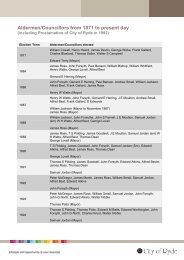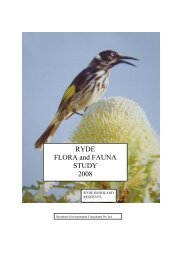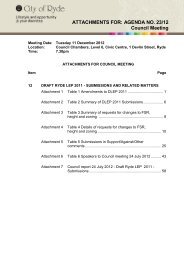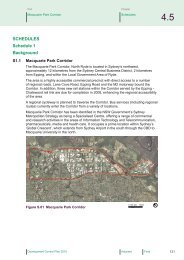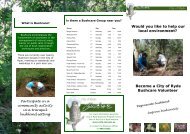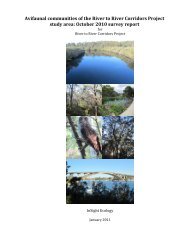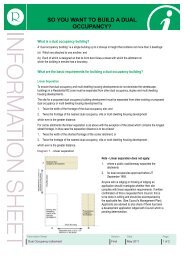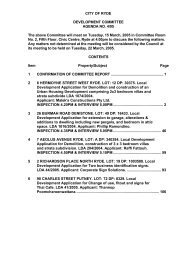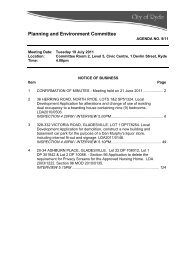RYDE FLORA and FAUNA STUDY 2007 - City of Ryde - NSW ...
RYDE FLORA and FAUNA STUDY 2007 - City of Ryde - NSW ...
RYDE FLORA and FAUNA STUDY 2007 - City of Ryde - NSW ...
You also want an ePaper? Increase the reach of your titles
YUMPU automatically turns print PDFs into web optimized ePapers that Google loves.
3.4 Fauna Survey<br />
a) Historical Data:<br />
Biosphere Environmental Consultants Pty Ltd<br />
<strong>Ryde</strong> Flora <strong>and</strong> Fauna Survey <strong>2007</strong> 19<br />
Although the purpose <strong>of</strong> the study was to create a snap-shot underst<strong>and</strong>ing <strong>of</strong> the<br />
fauna <strong>of</strong> the <strong>Ryde</strong> LGA, efforts were made to locate historic data for the area. <strong>Ryde</strong><br />
<strong>City</strong> Council had a partial fauna data base. These records were not the results <strong>of</strong><br />
systematic surveys but rather they constituted opportunistic sightings by residents or<br />
council staff, bush care volunteers <strong>and</strong> local conservation groups. As a result, they can<br />
be regarded as a complete record <strong>of</strong> the fauna.<br />
In addition, once the surveys commenced contact was made with a number <strong>of</strong> local<br />
residents <strong>and</strong> council staff working in the LGA. People were asked specific fauna<br />
questions <strong>and</strong> details were noted <strong>and</strong> later cross-checked.<br />
b) Field Surveys:<br />
The following techniques were used to sample the fauna:<br />
Small Ground Mammals:<br />
Single entrance, baited hair tubes were used in all <strong>of</strong> the bushl<strong>and</strong> areas. These tubes<br />
proved very successful in surveys carried out in other council areas (e.g. Kogarah<br />
Bushl<strong>and</strong> Reserves: Biosphere 1997; Rockdale LGA: Biosphere 1999). The tubes are<br />
used in preference to traps as they are less stressful on fauna, do not cause undue<br />
concern with the general public <strong>and</strong> are usually not interfered with by passers-by. Hair<br />
tubes remained at each site for a minimum <strong>of</strong> five days. They were then collected <strong>and</strong><br />
the hair samples forwarded to Dr David Read in Bathurst for hair analysis.<br />
The number <strong>of</strong> hair tubes set out depended on the size <strong>of</strong> the reserve. Table 3 lists the<br />
number <strong>of</strong> hair tubes that were used.<br />
Table 3<br />
Hair Tube Numbers<br />
RESERVE NAME NO. <strong>of</strong> HAIR<br />
TUBES<br />
LOCATION OF TUBES<br />
Forrester Park 10 Parallel with Terrys Creek<br />
Forsyth Park 10 Parallel with Terrys Creek<br />
Pembroke Park 75 Around the outer boundaries <strong>of</strong> the<br />
park <strong>and</strong> along the creek margins.<br />
Ivanhoe Reserve 10 Around perimeter <strong>of</strong> park<br />
Somerset Park 10 Through centre <strong>of</strong> reserve<br />
Pryor Park 10 Close to creek line<br />
Portius Park 25 Along s<strong>and</strong>stone exposure <strong>and</strong> creek<br />
line<br />
Kittys Creek Reserve 10 Centre <strong>of</strong> reserve<br />
Martin Reserve 5 Edges <strong>of</strong> reserve<br />
Minga Reserve 5 Edges <strong>of</strong> reserve<br />
Barton Reserve 10 Parallel with Buffalo Creek<br />
Pidding Park 25 Around boundaries <strong>of</strong> reserve<br />
Burrows Park 25 Parallel with creek line<br />
Memorial Park 10 Parallel with river foreshore




